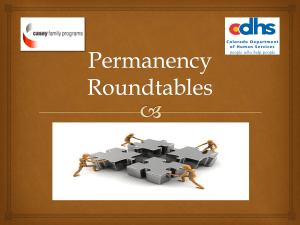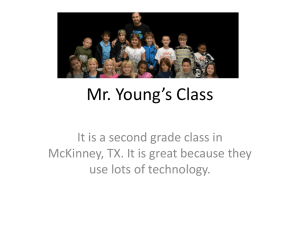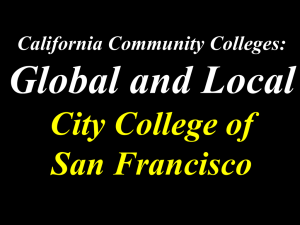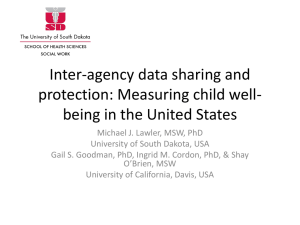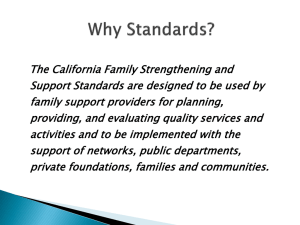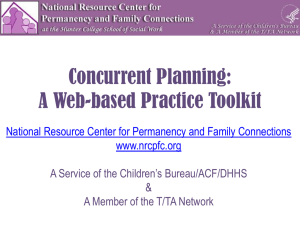the Webinar PowerPoint Presentation
advertisement
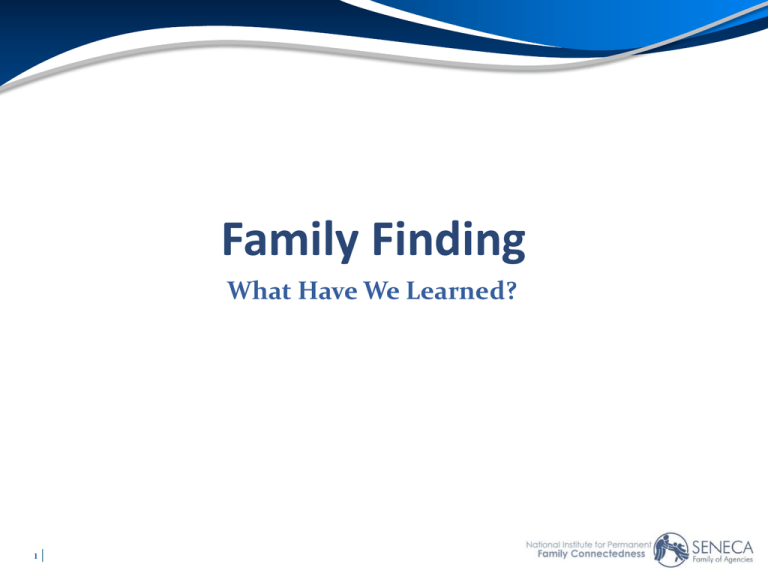
Family Finding What Have We Learned? 1| Agenda Opening/Introduction to Family Finding.…Bob Friend What Do Recent Evaluations Tell Us? ..........Karin Malm Lessons Applied …………………………………………..Melissa Mollard Family Finding Learning and Lessons ….…..Kevin Campbell Panel Questions Audience Questions - 2| Please submit questions in the chat box to the organizer at the bottom right of your screen. Webinar Objectives Share a summary of Family Finding research to date Identify the lessons learned from current grant work and the connection with family centered practices Examine the foundational questions underlying the development of Family Finding practice and its intended impacts Create a vibrant conversation to explore continuing questions and research 3| We must remember that every single day in out-of-home care is a crisis in the life of that child 4| The Family Finding Mission is to… connect each child with a family, so that every child may benefit from the lifelong connections only a family provides. 5| Bringing Family Finding to the Front-End Family Finding was originally developed to attend to the 6| most lonely and disconnected children In response to our mission, our attention has been drawn to the needs of children prior to their entry into care Family Finding focus changes when the goal is to prevent removal A rapidly moving timeline changes the mechanics of Family Finding process We are currently exploring Front-End adaptations to the Family Finding model to address this urgent need Flexibility of the Family Finding Approach By clearly establishing the essential elements present in the Family Finding intervention, Family Finding can be effectively blended with a number of other family centered strategies and interventions, including: Family Group Counseling/Family Group Decision Making Signs of Safety/Safety Organized Practice Trauma-informed practices Grief & loss work, e.g. Darla Henry’s 3-5-7 Model 7| Core Beliefs Inherent to Family Finding Every child has a family, and they can be found if we try Loneliness can be devastating, even dangerous, and is experienced by most children in out of home care A meaningful connection to family helps a child develop a sense of belonging The single factor most closely associated with positive outcomes for children is meaningful, lifelong connections to family 8| Goals of Family Finding Support foster youth in developing meaningful and enduring 9| connections with adults and their siblings, cousins, etc. Support youth in developing a healthy sense of identity and increased sense of belonging through connection with family and loved ones Ensure a safe and valued space for families to participate and have a voice in the decision-making process. Provide family members with the opportunity to meet their needs within their family system Provide young adults emerging from care with a devoted support team that will assist them to live safely and productively within their communities The Six Steps of the Family Finding Model Discovery Engagement Planning Decision Making Evaluation Follow-up on Supports 10 | Essential Components of the Family Finding Model Urgency Aligning professional and family resources to achieve 11 | permanency An expanded definition of permanency Effective relative search Family-driven processes Development of multiple plans Well-defined activities and strategies to engage family Definition of Permanency Both a process and a result that includes involvement of the youth as a participant or leader in finding a permanent connection with at least one committed adult who provides: - A safe, stable, and secure parenting relationship - Love - Unconditional commitment - Lifelong support in the context of reunification, a legal adoption, or guardianship, where possible Offering the legal rights and social status of full family membership, in which the youth has the opportunity to maintain contacts with important persons including brothers and sisters cite © California Permanency for Youth Project (CPYP), 2007 12 | Family Finding: What Do Recent Evaluations Tell Us? Karin Malm, Child Welfare Program Area Director August 15, 2013 13 www.childtrends.org Twitter/childtrends www.facebook.com/childtrends: Evaluations Recently Completed and Soon to Wrap Up • Federal Family Connection Discretionary Grants included evaluations of 12 Family Finding programs (cross-site report now available) • Child Trends’ evaluations – San Francisco Family Finding targeting children new to out-of-home care (completed) – North Carolina’s Family Finding efforts in 9 counties, targeting children 10+ years of age with few/no connections to family members (results not yet available) 14 Family Connections Family Finding Evaluations • Grantees serving children in care for extended periods of time had more difficulty placing children with relatives and/or moving them to permanency than grantees serving children new to out-of-home care • Among 4 grantees implementing an experimental design: – 2 found improved placement outcomes for children in treatment group compared to children in the control group – 2 found no significant differences in placement outcomes for children in treatment and control groups 15 Family Connections Family Finding Evaluations • Findings regarding average length of time in care were inconclusive as to whether family finding reduced length of stay of children served • Qualitative evidence from one grantee site indicated that family finding may divert placement into out-ofhome care • Approximately three quarters of the children served experienced increased family connections or had kinfocused permanency plans developed 16 Family Finding in San Francisco • San Francisco County had experience providing family finding to older youth who were disconnected from their families • Seneca Family of Agencies provided family finding to children first entering out-of-home care • Hypothesized that providing family finding at this early stage would increase the likelihood of reunification, increase the likelihood of the child being placed with kin, and decrease time to permanency 17 San Francisco Impact Evaluation Approach • Experimental design that randomly assigned children to receive family finding services (treatment) or services as usual (control) • Intake occurred for a period of 25 months (Sept 2008 to Feb 2011) and administrative data was extracted 12 months following the end of intake • Measure impact of treatment on child permanency, specifically reunification, placement with relatives, and exit from care (using administrative data) 18 San Francisco Evaluation Sample Total Treatment Control Enrolled in study 239 116 123 Received data on key outcome 224 111 113 Served by FF while in foster care 204 102 102 19 San Francisco Research Questions: Are children referred to family finding more likely than children in the control group… …to be reunified? …to be placed with relatives? …to have a permanency goal related to returning home? …to avoid placement disruptions? 20 San Francisco Descriptive Findings 100% Treatment 80% 60% Control 67% * 57% 47% 50% 66% 48% 52% 47% ** 40% 20% 0% Reunified (n = 204) *: p<.10 (*), p< .05 (**), p< .01 (***) 21 >=2 placements (n=202) Latest placement was with relative (n=202) Latest goal is related to returning home (n=182) San Francisco Descriptive Findings 100% Treatment 83% 80% 70% * 60% 40% 18% 20% 10% 0% Discharged from foster care during study period (n = 204) *: p<.10 (*), p< .05 (**), p< .01 (***) 22 Re-entered foster care, among those discharged (n=156) Reunification outcomes, by experimental group membership 100% 90% 80% 43% 53% 70% Not reunified 60% 50% Reunified w/ subsequent reentry 40% 30% 20% 43% 42% 10% Reunified w/ NO subsequent reentry 0% Treatment 23 Control San Francisco Evaluation: Review of Findings Compared to children not receiving family finding, children receiving family finding were: • No more likely to exit to reunification • No more likely to be placed with relatives • More likely to re-enter care after reunification • More likely to have the last goal as reunification • More likely to exit care, but no more likely to reenter overall 24 San Francisco Evaluation: Implications and Conclusions • The differing directives and timelines of the Family Finding specialists versus the caseworkers may have been a barrier in achieving impacts on reunification • Challenges to full model implementation suggest that more research is needed to determine whether and how fidelity to the model can be attained • Family finding is being implemented in context where multiple placement moves are to be avoided as much as possible, placement stability was viewed as an important practice goal 25 Contact Information: Karin Malm, kmalm@childtrends.org 240-223-9318 26 www.childtrends.org Twitter/childtrends www.facebook.com/childtrends Lessons Applied Melissa Mollard, Director of Research Seneca Family of Agencies 27 | Lifelong Connections Initiative In 2012, Seneca and San Francisco’s Human Service Agency were one of five grantees funded by the Children’s Bureau to implement a combined Family Finding/Family Team Meeting model of practice. 28 | Implementation Science Framework “Only when effective practices are fully implemented should we expect positive outcomes. Implementation matters” (Blase & Fixsen, 2005, p. 10). Children and families do not benefit from interventions that they don’t receive. 29 | Implementation Matters The Intervention Implementation EFFECTIVE NOT EFFECTIVE EFFECTIVE Actual benefits Inconsistent; not sustainable; poor outcomes NOT EFFECTIVE Poor outcomes Poor outcomes; possibly harmful Dean Fixsen et al., Implementation Research: A Synthesis of the Literature (2005), 69. 30 | Key Implementation Drivers Performance Assessment Systems Intervention Coaching Facilitative Administration Training Decision Support Data System Core Implementation Components Selection Leadership Technical 31 | National Implementation Research Network © Fixsen & Blase, 2008 Adaptive Competency Drivers Permanency Specialists a mix of veteran staff and new hires - Seasoned family finders provide mentorship to newly hired staff. Train staff in Family Finding model so that staff and supervisors can provide effective monitoring and feedback on an ongoing basis. Train staff in SF County practice model to ensure effective communication (“speaking the same language”) Our Permanency Specialists carry out all steps of Family Finding model and assist County social workers with the Family Team Meeting practice. - Training to County social workers in the combined model on-going, and our staff cross-trained in the County model 32 | Performance Assessment—Fidelity Tool Development Researchers, practitioners, supervisors, and trainers of the model worked collaboratively to develop a fidelity monitoring tool for the combined practice - Sections that Permanency Specialists complete - Sections for family members and other natural supports to complete - Supervisor attends to entire tool during formal supervision and compares across Permanency Specialists to detect trends in step completion 33 | Performance Assessment – Fidelity Monitoring Develop a plan for monitoring implementation of the program that includes data collection, observation of the program, analysis of the data, and planning for ways to address off-target implementation. Use the data collected regarding fidelity of implementation in efforts to identify possible reasons for the program not performing as expected. 34 | Performance Assessment—Outcome Measures Permanency measures - Reunification - Length of time in care - Re-entry into the system Well-being - Using a scaled down version of the Child and Adolescent Needs and Strengths (CANS) and measuring domains at entry and discharge with both treatment and control groups 35 | Organizational Drivers Our staff have desk space and work side-by-side with 36 | County social workers Staff have access to the CMS/CWS and enter information directly into the database Trainings for County social workers are happening during staff meetings using case consultation model. Seneca staff attending Safety-Organized Practice trainings and looking for common language and themes across practices Seneca has long-standing relationship with County with mutual trust and respect built over time Fidelity Tool Snapshot 37 | Combination Family Finding/Family Group Decision-Making Projects Olmsted County, Rochester, MN; Children's Home Society of Washington, Seattle, WA; Oregon Department of Human Services, Salem, OR; Seneca Family of Agencies, San Leandro, CA; Spaulding for Children, Southfield, MI. 38 | Family Finding: Learning and Lessons Kevin A. Campbell, Expert Trainer/Consultant and Author of the Family Finding model 39 | The Need for Family Finding Team based models like Wraparound, Family Group Conference and Family Group Decision Making are implemented in public child welfare systems with limited or no relative and birth father participation, significantly limiting their overall effectiveness. Family Finding Hypothesis: Strengthen the team, strengthen the plan. 40 | Foundational Family Finding Questions Is there a family for children in foster care for whom we have been told there is no one? A related question: Is there a father and can he be identified, located and engaged? Can they be found by case carrying staff? If they are found can they be effectively engaged and become part of planning and decision making? 41 | Answers We learn from this experience that child welfare workers also are affected by the isolation experiences of children and parents. Staff become the single source of support and advocacy for youth with to little time to do the work they came to do. 42 | There is a maternal family, there is a father, the father has relatives. There are also non-relative adults who have a historic connection of affection to children who can be identified Many sites when challenged could identify 40 or more of these people “You have something very unique in family finding. This is authentic, something…natural, because you didn’t come to divide, you come to construct. You bring families together” - Found Relative Child Trends. Client Voices: Youth, Parent and Relative Perspectives on Family Finding, May 2013. 43 | Importance of Client & Family Voices They should inform our priorities in practice - Be genuinely interested in the child’s and family’s well-being - Aim for cultural competency - Provide space for open of communication - Support the client and family as they work through the process Child Trends. Client Voices: Youth, Parent and Relative Perspectives on Family Finding, May 2013. 44 | Significant Differences in Family Finding at the Front-End The original six step Family Finding model requires modification when used at the front end of the system New questions arise, for example: - Who is the family finding for, the parent or the child? Need to balance the priorities of concurrent planning efforts while also prioritizing the voice of the parent in the team building and decision-making process. 45 | Progressing Beyond Timely Notice Additional impacts of Family Finding 46 | A Goal of Reducing Trauma Timely notice and rapid response can provide opportunities to reduce the trauma experienced by children in removal from parents and placement with strangers in foster care Diligent effort in identifying relatives and providing notice can limit or prevent the loss of dignity experienced by family members when children are removed by the court and agencies and placed with strangers 15 states now have legislation or directives implementing notice requirements in compliance with federal law 47 | Improvements in Adoption Practice Early notification and providing meaningful opportunities for family and community members to participate in decision-making creates a healthier adoption experience Relative adoption and overall adoption completion was significantly increased in Florida, Missouri and New York City Family Finding projects Providing meeting notice and opportunities for participation in decision-making improves the quality of outcomes for families affected by the child welfare system 48 | Indian Child Welfare Emphasizing additional identification of possible tribal affiliation and early notice of tribes and the courts improves the outcomes and well-being for Indian children, families and tribes. Implementing a meaningful process for extensively involving family, community and tribal members can dampen the effects of institutional racism frequently experienced by Indian families and children 49 | Lessons Learned So Far Family Finding projects and evaluations to date have taught us that: - Relatives , community members and tribes can be identified, located and noticed - Engaging these relatives can reduce the secondary trauma of preventable separation from relationships and membership in a larger family, community and tribe. - Long-term separation of siblings, grandparents and other relationships of significance is preventable - The child welfare system must join with relatives as a team to reduce trauma and end the loneliness experienced by children in the system 50 | Protecting the future… Increase support for and meaningful access to opportunities for sustained relationships for children separated from their connections by child welfare activities Prioritize the preservation and continuity of these relationships as critical to protecting developing children across their lifespan Increase recognition of the significant role attachment and affection play in shaping healthy brain architecture throughout development Focus public policy on not only who will be the parent, but who will be visiting and allowing the child regular involvement in normative family, community and tribal activities 51 | To truly improve America’s Child Welfare System we must invest not only in protecting children today from abuse and neglect, but also protect their futures by reducing mental and physical harm experienced while they wait for resolution within the system. The family teams created through Family Finding provide children and youth with a network to provide lifetime support, reduce harm and promote well-being for each child. There is no question that creating and sustaining this lifetime support network requires time and resources. These investments are critical to truly improving the child welfare system. 52 | Panel Question I What have we learned from measuring Family Finding and other innovative practices that can improve the quality of future implementation? 53 | Panel Question II While anecdotally those who train Family Finding believe that this approach has helped thousands of foster youth become better connected, and for some attain legal permanency, why have we not seen more evidence supporting these observations? 54 | Audience questions 55 | Resources Six Steps for Family Finding http://familyfinding.org/uploaded_files/fck/files/FF%20Six%20Steps.doc Child Trends - Client Voices: Youth, Parent and Relative Perspectives on Family Finding http://familyfinding.org/uploaded_files/fck/files/Child_Trends2013_05_01_RB_ClientVoices.pdf Child Trends - Family Finding: Does Implementation Differ When Serving Different Child Welfare Populations? http://familyfinding.org/uploaded_files/fck/files/Child%20Trends%20Oct%202011.pdf Child Trends Family Finding San Francisco Report http://www.childtrends.org/?publications=family-finding-for-children-and-families-new-toout-of-home-care-a-rigorous-evaluation-of-family-finding-in-san-francisco Family Connections Cross-Site Evaluation Report http://www.nrcpfc.org/grantees_public/2009/Fam%20Conn%202009%20CrossSite%20Final%20Report%206-17-13.pdf Additional Family Finding resources and information http://familyfinding.org/resourcesandpublications.html 56 | Thank you for attending! See follow up emails for: - Access to resources mentioned during this webinar - Means to provide feedback so we can make improvements to future webinars - Where to find a posting of the recorded webinar Please send your questions, comments and feedback to: familyfinding@senecacenter.org. 57 |




